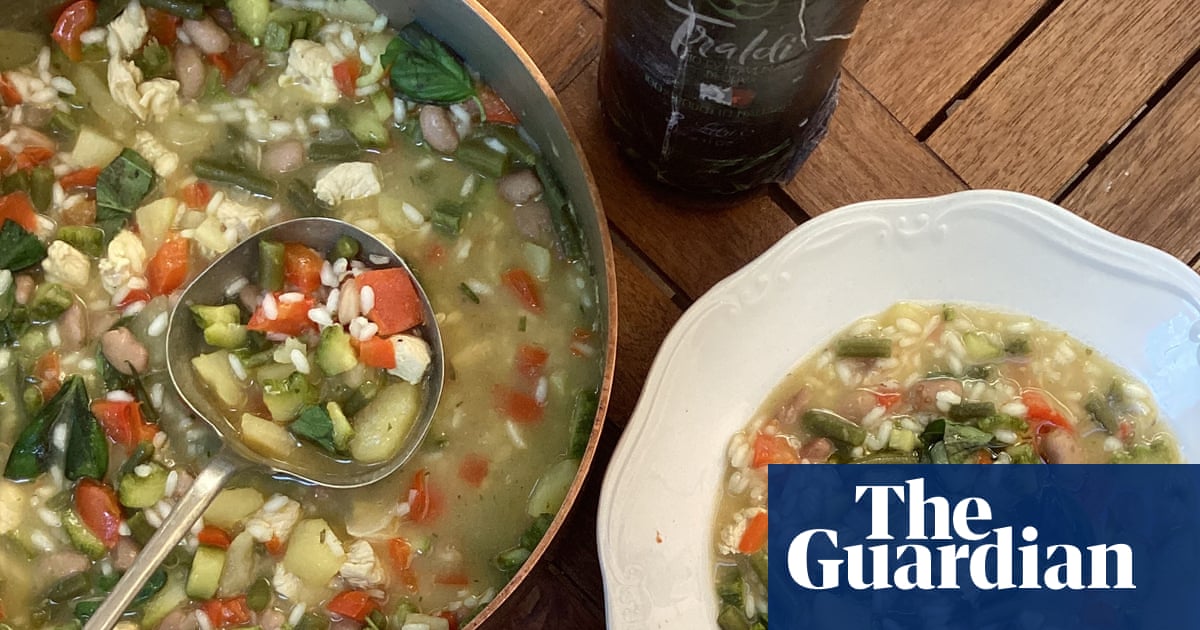
While fregula is the most satisfying packet of pasta to grab from the shelf, the balls rolling and rising like a stress ball under fingers, bags of anelli (little rings) come a close second. They are also useful. Once, on the return journey from Palermo to Naples, three 1kg bags of Poiatti’s Anelli Siciliani No 3 wrapped in a towel made a half-decent pillow and defence against the thinly carpeted lobby of a Grimaldi Lines night ferry. A night that began with chips, several mini bottles of red wine each and rounds of cards next to a man who was one of the greatest lounge electric pianists we had ever heard, ended with cheeks on pasta.
It is in Sicily and Puglia where anelli (also the smaller anelletti, little rings) are most typical and often by far the best-stocked shape in shops and the highest pile on market stalls. In the small supermarket next to my partner’s family home in Gela on the south coast of Sicily, for example, 20 other shapes share three shelves, while rings of various sizes enjoy their own. Anelli can be served with sauce or in soup, but they are typically used for timballo al forno: the rings boiled for less time than usual, mixed with tomato sauce or ragù, reinforced with cheese, maybe vegetables, packed into a breadcrumbed tin and baked until golden. It is not only their form that makes rings so suited to baked pasta – especially timballi that you invert – it’s their substance. Despite their neat, small, curtain-ring form, less than 2cm in diameter anelli and anelletti are sturdy shapes that have a surprisingly long cooking time – Poiatti, for example, recommends 15 minutes for anelli. This is timing you jig when you make baked pasta – let’s say 10 for the boil, the rest in the oven.
But this isn’t another column about baked pasta. It’s a column about the fact that, even though I make versions of minestrone all year round, when autumn arrives, holding tights and the other half of the detachable duvet, the need for big soup is great. This one is full of good things that are around right now – mushrooms, potato, pumpkin or butternut squash, with pasta, if you wish: anelli if you can find them, another small shape if you can’t.
A bit of dried, crumbled red chilli/peperoncino is welcome in this minestrone. You could add it once the carrot, onion and celery are soft, and how much you add is up to you and the strength of your chilli. Alternatively, mix a teaspoon or so of dried flakes (or some finely chopped red chilli) with a few tablespoons of olive oil, then cautiously zigzig the red-flecked oil on top of your big soup with useful rings.
Autumn minestrone with anelli (or other small pasta)
Prep: 15 min
Cook/soak: 30 min
Serves 4
20g dried porcini
4 tbsp olive oil, plus extra to finish
1 knob butter
1 onion, peeled and diced small
1 stick celery, diced small
1 carrot, peeled and diced small
1 sprig fresh rosemary
1 potato, peeled and diced small
200g butternut squash flesh, diced small
100g field mushrooms, chopped
200g anelli, broken spaghetti or other small pasta
Dried, crumbled red chilli/peperoncino, to taste
Soak the porcini in 150ml warm water for 20 minutes. Lift out the soaked mushrooms, then filter the soaking liquid and top it up with water to make 1.2 litres.
Meanwhile, in a large, heavy-based pan, warm the oil and butter, and gently fry the onion, celery, carrot, rosemary and a pinch of salt until soft and translucent.
Add the potato, squash and mushrooms, fry, stirring, for a few minutes more, then add the liquid and bring to a boil. Turn down to a simmer and cook for 30 minutes, then add the pasta and continue cooking, stirring regularly, until it is tender, adding more water if you think it needs it.
Mix a teaspoon or so of dried chilli flakes (or some finely chopped red chilli) with a few tablespoons of olive oil, then cautiously zigzig on top of the soup before serving.
UK readers: click to buy these ingredients from Ocado












